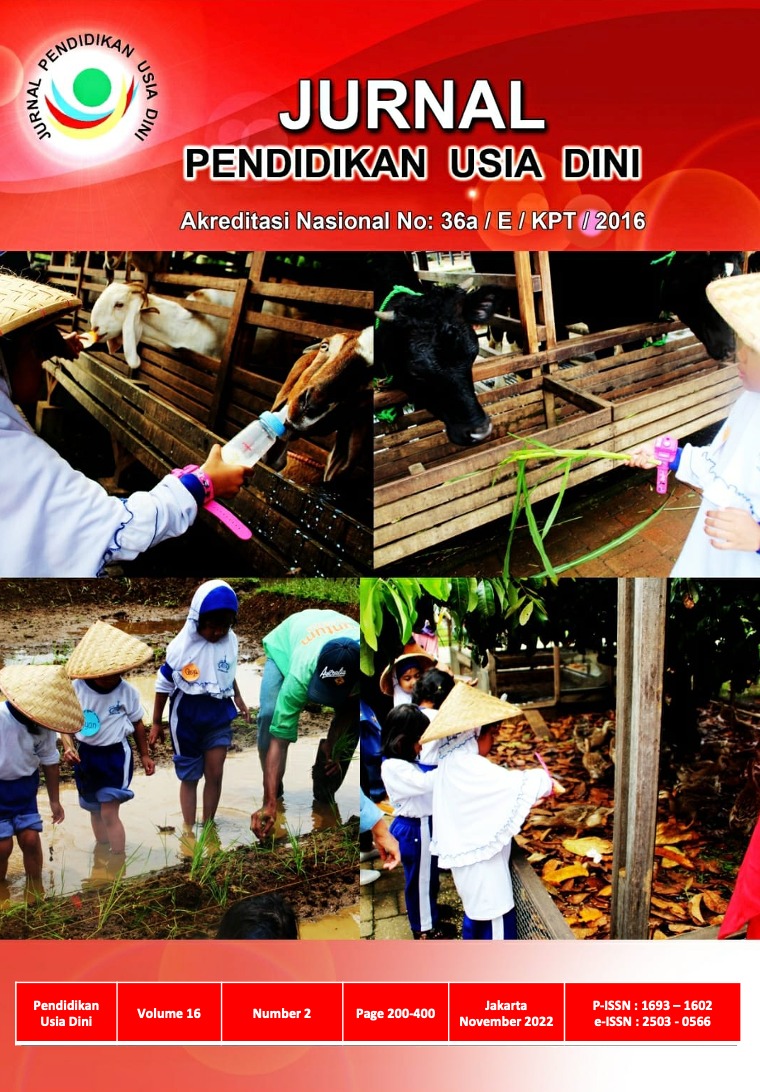Enhancing Children's Vocabulary Mastery Through Storytelling
DOI:
https://doi.org/10.21009/JPUD.162.05Abstract
Significant language development differences occur in preschoolers, resolving these differences is a key objective of preschool education because young children's language abilities at the start of school, particularly their vocabulary abilities, are a strong predictor of later academic ability. Storytelling is one of the methods used to teach English, it makes the learning environment more interesting, energetic, and conversational. This study aims to examine storytelling in increasing children's vocabulary. The research method is a case study that uses observation, interviews, and documentation as data collection tools. The participants are an English teacher and seven children aged 4-5 years. Although, many early childhoods English teachers state that one of the weaknesses of children in learning English is a lack of vocabulary mastery because it can hamper the learning process. The findings show that storytelling is effective in increasing children's vocabulary. Vocabulary is the foundation for improving children's ability to speak English, both orally and in writing. Second language vocabulary is important to learn and develop for the quality of early childhood learners in language education.
Keywords: early childhood, vocabulary, storytelling
References:
Agosto, D. E. (2016). Why Storytelling Matters: Unveiling the Literacy Benefits of Storytelling. Children and Libraries, 14(2), 21. https://doi.org/10.5860/cal.14n2.21
Chubb, J., Missaoui, S., Concannon, S., Maloney, L., & Walker, J. A. (2022). Interactive Storytelling for Children: A Case-Study of Design and Development Considerations for Ethical Conversational AI. Int. J. Child-Comp. Interact., 32(C). https://doi.org/10.1016/j.ijcci.2021.100403
Dewi, E. N. F., Hasanah, N., & Nurul, M. F. (2022). Enhancing Students’ Vocabulary Through Story Telling. EDULEC JOURNAL: Education, Language, and Culture.
Egan, K. (1989). Teaching as Story Telling: An Alternative Approach to Teaching and Curriculum in the Elementary School. University of Chicago Press. https://books.google.com.mt/books?id=zNdLGAPzQT8C
Ekawati, A. D. (2022). The Implementation of Total Physical Response (TPR) to Improve Student’s English Vocabulary During Pandemic. English Journal, 16(1).
Fadli, M. R. (2021). Understand the design of qualitative research methods. humanics, [Memahami desain metode penelitian kualitatif]. Humanika, 21(1).
Isik, M. A. (2016). The Impact of Storytelling on Young Ages. European Journal of Language and Literature Studies Articles, 2, 3.
Kaur, A., Young, D., & Kirkpatrick, R. (2016). English Education Policy in Thailand: Why the Poor Results? In R. Kirkpatrick (Ed.), English Language Education Policy in Asia (Vol. 11, pp. 345–361). Springer International Publishing. https://doi.org/10.1007/978-3-319-22464-0_16
Khudhair, N. K., & Alnoori, B. S. M. (2017). Investigating EFL Preparatory School Teachers’ Perceptions Toward Using Storytelling Technique. Route Educational and Social Science Journal, 4(6).
Kristiawan, D., Ferdiansyah, S., & Picard, M. (2022). Promoting Vocabulary Building, Learning Motivation, and Cultural Identity Representation through Digital Storytelling for Young Indonesian Learners of English as a Foreign Language.
Ling, N. S., & Abdul Aziz, A. (2022). The Effectiveness of Game-based Learning Strategies on Primary ESL Learners’ Vocabulary Learning. International Journal of Academic Research in Progressive Education and Development, 11(2), Pages 845-860. https://doi.org/10.6007/IJARPED/v11-i2/13266
Malik, H., Humaira, M. A., Komari, A. N., Fathurrochman, I., & Jayanto, I. (2021). Identification of barriers and challenges to teaching English at an early age in Indonesia: An international publication analysis study. Linguistics and Culture Review, 5(1), 217–229. https://doi.org/10.21744/lingcure.v5n1.1485
McKay, P., & Guse, J. (2007). Five-Minute Activities for Young Learners. Cambridge University Press. https://books.google.co.id/books?id=BWKXLgrSv6gC
Mufida, A., & Abidin, M. R. (2021). Designing a Board Game as a Media for Learning English for Children Aged 6-10 Years [Perancangan Board Game Sebagai Media Pembelajaran Bahasa Inggris Anak Usia 6-10 Tahun]. Jurnal Barik, 2(3). https://ejournal.unesa.ac.id/index.php/JDKV/
Noom-ura, S. (2013). English-Teaching Problems in Thailand and Thai Teachers’ Professional Development Needs. English Language Teaching, 6(11), p139. https://doi.org/10.5539/elt.v6n11p139
Pertiwi, A. B., Rahmawati, A., & Hafidah, R. (2021). English Vocabulary Learning Methods in Early Childhood [Metode Pembelajaran Kosakata Bahasa Inggris Pada Anak Usia Dini]. Kumara Cendekia, 9(2), 95. https://doi.org/10.20961/kc.v9i2.49037
Rahiem, M. D. H. (2021). Storytelling in early childhood education: Time to go digital. International Journal of Child Care and Education Policy, 15(1), 4. https://doi.org/10.1186/s40723-021-00081-x
Stargatt, J., Bhar, S., Bhowmik, J., & Al Mahmud, A. (2022). Digital Storytelling for Health-Related Outcomes in Older Adults: Systematic Review. J Med Internet Res, 24(1), e28113. https://doi.org/10.2196/28113
Sunyakul, N., & Teo, A. (2020). Primary School English Teachers’ Application of Knowledge/Skills from Boot Camp to Their Classroom Teaching Practices and Factors Hindering Their Application. 13(1).
Tarigan, H. G. (1986). Menulis sebagai suatu keterampilan berbahasa. Angkasa. https://books.google.co.id/books?id=XXoBtwAACAAJ
Thornbury, S. (2002). How to teach vocabulary. Pearson educational. https://books.google.co.id/books?id=5qLkoAEACAAJ
Udaya, M. (2022). Using Semantic Maps as A Teaching Strategy for Vocabulary Development. European Journal of English Language Teaching, 6(5). https://doi.org/10.46827/ejel.v6i5.4095
Zu, Y., Cheng, Z., Sun, Q., & Zhao, H. (2021). On the Problems and Countermeasures in English Vocabulary Teaching in Junior Middle Schools. 568.
Downloads
Published
How to Cite
Issue
Section
License
JURNAL PENDIDIKAN USIA DINI work is licensed under a Creative Commons Attribution 4.0 International License. (http://creativecommons.org/licenses/by/4.0/)





